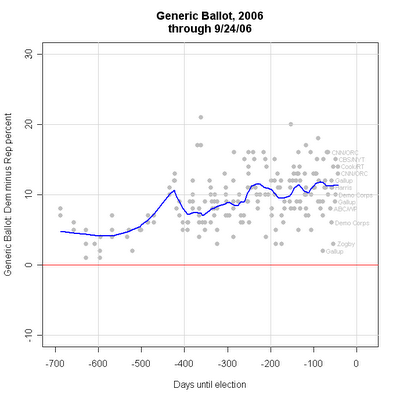
After a flurry of polls indicated a dip last week, the generic ballot for the House now appears to have stabilized. Last week the Democratic lead (that is, Dem% minus Rep%) fell from +12 to +10. New polling however suggests that the dip was less and now estimates the Democratic lead at +11.4%. More important, the upturn in Bush approval rating that remains quite strong now appears not to be driving the generic ballot, as it seemed to be doing last week. (See the latest approval trend here.) With the new data, the dip appears mild and the trend is now flat. This is not out of line with Senate polls which have so far failed to show a move in the Republican direction over the past couple of weeks.
The range of values on the generic ballot is striking. While all polling is variable, it is clear from the polls indicated in the right of the figure, that this question produces a strikingly large range of results. In part this is a simple artifact of the measure being the LEAD of Dems over Reps. The variability of a difference is larger than the variability of either of its components. So if the margin of error for the Dems and for the Reps is 3%, the margin of error for the difference is close to 6%. Even so, readers would be well advised to be wary of highly variable polling on the generic ballot. A lot of attention is being paid to this measure which is certain to vary a lot from poll to poll. Simply looking at the latest poll compared to the previous is likely to vastly overstate amount of change that is taking place. That variability also means it is hard to know precisely where the measure stands, based on individual polls. The trend (blue line in the figure) is the best estimate. And remember, translating the generic vote margin into seats is also an uncertain business. See here.
Click here to go to Table of Contents